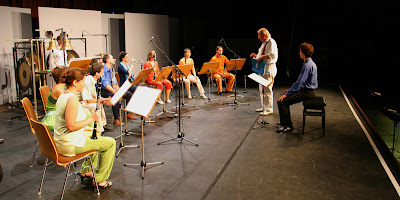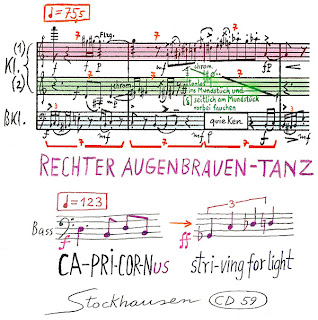Working with Karlheinz Stockhausen - The art of performing
Dress rehearsal, August 2003.

As an homage to Karlheinz Stockhausen, I want to share with you a text I wrote in 2003, right after working with the composer. Several noteworthy aspects of his work have not been given much importance in the comments after his passing away. One of them is the importance of performance practice in his music. That's one of the memories we musicians will keep after having performed the world première and recorded Rechter Augenbrauentanz (The Dance of the Right Eyebrow).
The musicians
- clarinet and solo Eb clarinet: Michele Marelli
- clarinets: Rumi Sota-Klemm (by the way, Rumi played basset-horn in Montag aus Licht), Antonia Lorenz, Roberta Gottardi, Maja Pawelke, Jean-François Charles
- bass clarinets: Petra Stump and Heinz-Peter Linshalm
- synthesizer: Antonio Pérez Abellán
- percussion: Michael Pattmann
- conductor: Adrian Heger
In the recording studio, August 2003.

Impressions (2003)
Stockhausen is a master in performance practice. Admittedly, he is first and foremost a composer, but he also has a real gift for getting the best out of the interpreters who work with him. His commitment, experience and inner ear make his presence at rehearsals very effective.

Rechter Augenbrauentanz is a composition for two clarinet voices, one bass clarinet voice, percussion, and synthesizer. We premièred the piece with six clarinets, two bass clarinets, percussion, and synthesizer, under Adrian Heger's conducting and Karlheinz Stockhausen's musical direction. For this piece lasting roughly half an hour, the ten days of rehearsals have been well occupied. Indeed, a correct performance of the piece must be played with a high synchronization between the different voices (it is obvious when we play Mozart's Gran Partita, but it is sometimes forgotten in what is called "contemporary classical music"). Moreover, Stockhausen pays much attention to the careful balance between the different voices. The balance between such high note of the first clarinets and such medium note clarinets of the seconds may require extensive testing, correcting, etc.
Like all scores from Stockhausen Verlag, the parts were of very high quality. Because it was a premiere, the composer wanted to check and correct some of the details: a rallentando, a dynamic marking, a pause or a breath were specified so that the music breathes, lives.
And always his interest for performance practice: he asks to play repeated notes repeated "as if we spoke," he emphasized the dance character of the piece ("a dance with ballet shoes, with no boots!") Anyone who has played his music knows that the music of Stockhausen is not reductible to a formula that unfolds. It is also much work closely with interpreters. This was once again the case with Rechter Augenbrauentanz. The good work environment is also important to note (importantly enough thanks to Suzanne Stephens) and we could feel that during the première concert, when each musician gave his best and we all took a real pleasure to play.
During the rehearsals (picture Heinz-Peter Linshalm.)




Comments
Post a Comment